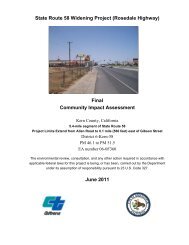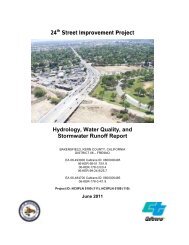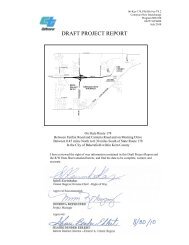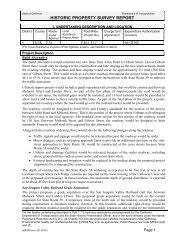State Route 58 Widening Project - Bakersfield Freeways
State Route 58 Widening Project - Bakersfield Freeways
State Route 58 Widening Project - Bakersfield Freeways
Create successful ePaper yourself
Turn your PDF publications into a flip-book with our unique Google optimized e-Paper software.
Chapter 3.<br />
Results: Environmental<br />
Setting<br />
3.1. Description of Existing Biological and Physical<br />
Conditions<br />
3.1.1. Study Area<br />
The BSA is located along SR-<strong>58</strong> in the City of <strong>Bakersfield</strong>, in Kern County,<br />
California. The BSA includes the current highway pavement and shoulders, ROW,<br />
and a buffer zone extending 500 feet north and south of it (Figures 3A–3C). The BSA<br />
is located in the western portion of the MBHCP on the USGS’s 7.5-minute Rosedale<br />
and Oildale quadrangles (Figure 4).<br />
Several watercourses are located within, or in proximity to, the BSA. The Kern River<br />
is located southeast of the BSA boundary, the Friant-Kern Canal crosses the BSA just<br />
east of Coffee Road, the Calloway Canal crosses the BSA at multiple locations in the<br />
eastern portion of the BSA, and Emery Ditch occurs north of SR-<strong>58</strong> just east of the<br />
Calloway Canal.<br />
Land uses in the BSA include commercial, industrial, and residential development as<br />
well as some undeveloped lots interspersed with the developed areas.<br />
3.1.2. Physical Conditions<br />
The BSA is located in the southern San Joaquin Valley, which is in the southernmost<br />
basin of the Great Central Valley of California. Topography in the BSA is generally<br />
flat with elevation ranges from approximately 365 to 400 feet above mean sea level.<br />
The SJVR crosses SR-<strong>58</strong> west of SR-99 at Landco Drive and again east of Allen<br />
Road.<br />
The following soil types are located within the BSA: Cajon loamy sand, Cajon sandy<br />
loam and Wasco sandy loam. None of these soils are considered to be hydric<br />
(Reed 1988).<br />
<strong>State</strong> <strong>Route</strong> <strong>58</strong> <strong>Widening</strong> <strong>Project</strong> Biological Assessment 21








